How Hidden Movement Flaws in Baseball Throwing Mechanics Limit Your Velocity
- JDS1 Marketing
- Oct 31
- 5 min read

“Fix the kinetic chain, not just the arm.”
If you’ve hit a velocity plateau or feel constant shoulder tightness after throwing, you’re not alone. Many pitchers and position players face the same challenge: putting in the work but not seeing progress. The truth is, you can train harder all day, but unless your baseball throwing mechanics are efficient, your body will always hold you back.
Let’s unpack how small movement flaws can limit your throwing velocity and what you can do to correct them.
Key Takeaways
Baseball throwing mechanics depend on efficient sequencing from the ground up.
Poor timing or rotation reduces velocity and increases shoulder stress.
Small adjustments in mechanics can lead to major performance gains.
Objective testing provides clear data to guide safer, faster improvement.
Where Your Power Really Comes From
Throwing a baseball isn’t just an arm movement; it’s a full-body sequence known as the kinetic chain. This chain connects your lower body, core, and upper body in a coordinated series of movements that build and release energy into the throw.
When everything fires in the right order, the motion looks effortless. The hips drive, the torso rotates, and the arm follows through like a whip. But when one link in that chain misfires, your arm compensates. Over time, this not only stalls your velocity, it also increases the risk of shoulder and elbow pain.
Think of your body like a series of gears. If one gear slips or spins out of sync, the entire machine loses efficiency. That’s what happens when your lower and upper body aren’t working together.
Common Flaws in Baseball Throwing Mechanics

Every athlete’s throwing motion is unique, but most velocity issues stem from a few key mechanical breakdowns. Understanding these flaws can help you pinpoint what’s holding you back.
1. Poor Trunk–Pelvis Timing
The most overlooked flaw in throwing mechanics is the timing between your pelvis and your torso. If your hips rotate too early or too late, the energy from your lower body doesn’t transfer cleanly to your upper body. This timing error often shows up as shoulder fatigue or inconsistent velocity from game to game.
2. Weak Front Side Stability
When your lead leg lands during the throw, it needs to stay strong and stable to stop forward momentum and redirect energy upward. If your front side collapses or shifts, you lose torque, forcing your arm to overwork to make up for it.
3. Limited Hip Mobility
Tight hips prevent full rotation, which limits how much torque your body can generate. Many athletes think stretching their arms will help their throwing motion, but in reality, their hips are restricting the energy flow long before it reaches the shoulder.
4. Early Arm Acceleration
If your arm starts accelerating before your body is ready, you’re effectively throwing with only your upper body. This disconnect between the legs and torso robs you of velocity and puts extra strain on your rotator cuff.
Each of these flaws disrupts the smooth energy transfer that makes throwing powerful and efficient. The fix isn’t more throwing; it’s understanding how your body moves.
Why Traditional Throwing Drills Aren’t Enough

Throwing mechanics are complex. Standard pitching drills help with rhythm and arm slot, but often miss what’s happening deeper in your body’s motion chain.
You might improve your arm speed temporarily, but without correcting timing, stability, and rotational sequencing, those gains won’t last. This is why so many athletes hit a performance wall despite long hours of practice.
Instead of guessing, the goal should be to measure how your body is actually moving. Once you can see your mechanical timing in real numbers, you can train smarter and fix the exact source of inefficiency.
The Role of Rotational Power in Velocity
Velocity isn’t just about arm strength; it’s about how efficiently you rotate. Most of the power behind a fast throw comes from the lower half of your body, especially the hips and torso.
When your trunk rotation is delayed or unbalanced, your body can’t fully harness its rotational power. The arm ends up throwing “alone,” which not only caps your velocity but also leads to overuse injuries.
Building rotational strength and coordination through targeted drills can restore balance in your kinetic chain. More importantly, it ensures the energy you generate travels efficiently from your legs all the way to your fingertips.
Signs You Have a Movement Efficiency Problem
You might not even realize your throwing mechanics are off because the symptoms can be subtle. Look out for these telltale signs:
Velocity that peaks early in the season and then drops
Shoulder or elbow soreness after long throwing sessions
Inconsistent command despite good effort
Feeling “tight” or restricted in your hips or torso
Noticeable fatigue after shorter outings
If any of these sound familiar, you’re likely compensating for a breakdown in your kinetic chain.
How to Improve Baseball Throwing Mechanics

You can make meaningful progress by focusing on three key areas: sequencing, stability, and timing.
1. Work on Lower-Body Sequencing
Try this simple drill: stand in your throwing stance, rotate your hips toward the target while keeping your shoulders closed, then release. This helps train your body to lead with your hips, an essential move for efficient energy transfer.
2. Strengthen Core Stability
Your core connects the lower and upper body, so weakness here disrupts energy flow. Planks, anti-rotation holds, and medicine ball throws are excellent ways to reinforce your core’s ability to transfer force.
3. Train Timing with Feedback
Use video or biomechanics testing to analyze when your hips, torso, and arm fire. Seeing your movement in slow motion gives you a clearer sense of how to sync each part.
How Data Helps You Find Hidden Flaws

Many athletes think they’re moving correctly, but the body can compensate so well that inefficiencies go unnoticed. That’s where biomechanics testing comes in.
At Analytics for Athletes in Medford, NJ, we use the Proteus Power Assessment to measure rotational power and identify timing issues between your hips and trunk. This technology gives you precise feedback on where your throwing motion breaks down.
Once those inefficiencies are mapped, our team develops a personalized plan to help you correct sequencing and build rotational symmetry. You’ll move more efficiently, reduce shoulder stress, and see measurable gains in velocity.
Our 4-step method, Test → Analyze → Protocol → Retest, ensures every improvement you make is based on real data, not guesswork. The process turns vague mechanical cues into clear, actionable insights.
When Mechanics and Recovery Work Together

Efficient throwing mechanics don’t just improve velocity; they extend your career. By aligning your movement patterns, you decrease stress on your joints and improve recovery between outings.
Many pitchers discover that fixing their timing and balance eliminates nagging pain they once thought was “normal.” Better mechanics mean less compensation, smoother movement, and a body that can handle the demands of the game more easily.
Ready to Find the Hidden Flaws Limiting Your Velocity?

You’ve done the strength work, fine-tuned your grip, and spent hours throwing bullpen sessions. Now it’s time to understand what your body is really doing during every throw.
At Analytics for Athletes, our Proteus Power Assessment measures how efficiently you rotate and transfer power through your kinetic chain. By identifying the small movement flaws that limit velocity, you’ll learn exactly how to unlock your throwing potential safely.
Book your Proteus Power Assessment today and see the difference precision data can make. Stop guessing and start throwing smarter, faster, and stronger.






